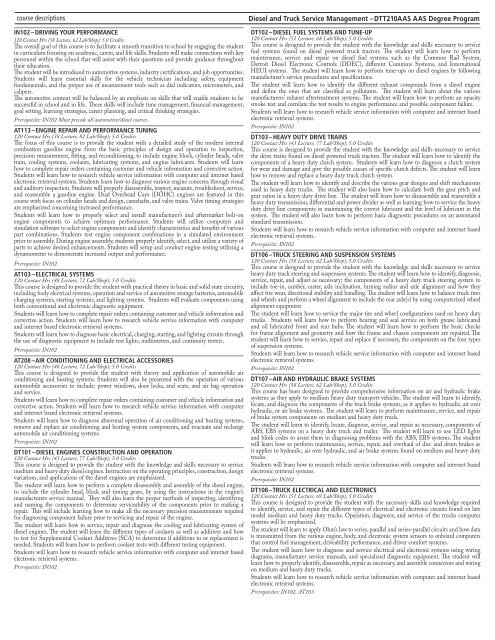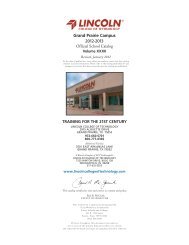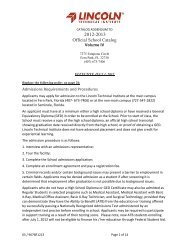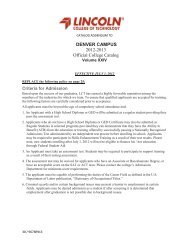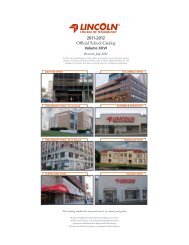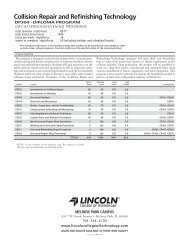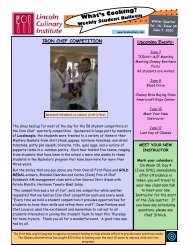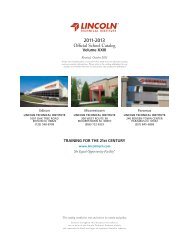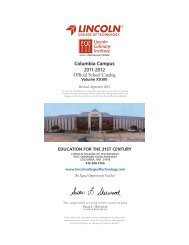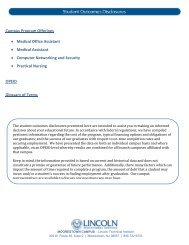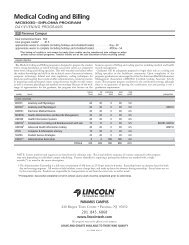to download the PDF - Lincoln Technical Institute
to download the PDF - Lincoln Technical Institute
to download the PDF - Lincoln Technical Institute
You also want an ePaper? Increase the reach of your titles
YUMPU automatically turns print PDFs into web optimized ePapers that Google loves.
course descriptions<br />
IN102 – Driving Your Performance<br />
120 Contact Hrs (58 Lecture, 62 Lab/Shop); 5.0 Credits<br />
The overall goal of this course is <strong>to</strong> facilitate a smooth transition <strong>to</strong> school by engaging <strong>the</strong> student<br />
in curriculum focusing on academic, career, and life skills. Students will make connections with key<br />
personnel within <strong>the</strong> school that will assist with <strong>the</strong>ir questions and provide guidance throughout<br />
<strong>the</strong>ir education.<br />
The student will be introduced <strong>to</strong> au<strong>to</strong>motive systems, industry certifications, and job opportunities.<br />
Students will learn essential skills for <strong>the</strong> vehicle technician including safety, equipment<br />
fundamentals, and <strong>the</strong> proper use of measurement <strong>to</strong>ols such as dial indica<strong>to</strong>rs, micrometers, and<br />
calipers.<br />
The au<strong>to</strong>motive content will be balanced by an emphasis on skills that will enable students <strong>to</strong> be<br />
successful in school and in life. These skills will include time management, financial management,<br />
goal setting, learning strategies, career planning, and critical thinking strategies.<br />
Prerequisite: IN102 Must precede all au<strong>to</strong>motive/diesel courses.<br />
AT113 – Engine repair and performance tuning<br />
120 Contact Hrs (38 Lecture, 82 Lab/Shop); 5.0 Credits<br />
The focus of this course is <strong>to</strong> provide <strong>the</strong> student with a detailed study of <strong>the</strong> modern internal<br />
combustion gasoline engine from <strong>the</strong> basic principles of design and operation <strong>to</strong> inspection,<br />
precision measurement, fitting, and reconditioning, <strong>to</strong> include engine block, cylinder heads, valve<br />
train, cooling systems, coolants, lubricating systems, and engine lubricants. Students will learn<br />
how <strong>to</strong> complete repair orders containing cus<strong>to</strong>mer and vehicle information and corrective action.<br />
Students will learn how <strong>to</strong> research vehicle service information with computer and internet based<br />
electronic retrieval systems. Students learn how <strong>to</strong> diagnose various engine concerns through visual<br />
and audi<strong>to</strong>ry inspection. Students will properly disassemble, inspect, measure, troubleshoot, service,<br />
and reassemble a gasoline engine. Dual Overhead Cam (DOHC) engines are featured in this<br />
course with focus on cylinder heads and design, camshafts, and valve trains. Valve timing strategies<br />
are emphasized concerning increased performance.<br />
Students will learn how <strong>to</strong> properly select and install manufacturer’s and aftermarket bolt-on<br />
engine components <strong>to</strong> achieve optimum performance. Students will utilize computers and<br />
simulation software <strong>to</strong> select engine components and identify characteristics and benefits of various<br />
part combinations. Students test engine component combinations in a simulated environment<br />
prior <strong>to</strong> assembly. During engine assembly, students properly identify, select, and utilize a variety of<br />
parts <strong>to</strong> achieve desired enhancements. Students will setup and conduct engine testing utilizing a<br />
dynamometer <strong>to</strong> demonstrate increased output and performance.<br />
Prerequisite: IN102<br />
AT103 – Electrical Systems<br />
120 Contact Hrs (48 Lecture, 72 Lab/Shop); 5.0 Credits<br />
This course is designed <strong>to</strong> provide <strong>the</strong> student with practical <strong>the</strong>ory in basic and solid state circuitry,<br />
including body electrical systems, operation and service of au<strong>to</strong>motive s<strong>to</strong>rage batteries, au<strong>to</strong>mobile<br />
charging systems, starting systems, and lighting systems. Students will evaluate components using<br />
both conventional and electronic diagnostic equipment.<br />
Students will learn how <strong>to</strong> complete repair orders containing cus<strong>to</strong>mer and vehicle information and<br />
corrective action. Students will learn how <strong>to</strong> research vehicle service information with computer<br />
and internet based electronic retrieval systems.<br />
Students will learn how <strong>to</strong> diagnose basic electrical, charging, starting, and lighting circuits through<br />
<strong>the</strong> use of diagnostic equipment <strong>to</strong> include test lights, multimeters, and continuity testers.<br />
Prerequisite: IN102<br />
AT208 – Air Conditioning and Electrical Accessories<br />
120 Contact Hrs (48 Lecture, 72 Lab/Shop); 5.0 Credits<br />
This course is designed <strong>to</strong> provide <strong>the</strong> student with <strong>the</strong>ory and application of au<strong>to</strong>mobile air<br />
conditioning and heating systems. Students will also be presented with <strong>the</strong> operation of various<br />
au<strong>to</strong>mobile accessories <strong>to</strong> include: power windows, door locks, and seats, and air bag operation<br />
and service.<br />
Students will learn how <strong>to</strong> complete repair orders containing cus<strong>to</strong>mer and vehicle information and<br />
corrective action. Students will learn how <strong>to</strong> research vehicle service information with computer<br />
and internet based electronic retrieval systems.<br />
Students will learn how <strong>to</strong> diagnose abnormal operation of air conditioning and heating systems,<br />
remove and replace air conditioning and heating system components, and evacuate and recharge<br />
au<strong>to</strong>mobile air conditioning systems.<br />
Prerequisite: IN102<br />
DT101 – Diesel Engines Construction and Operation<br />
120 Contact Hrs (43 Lecture, 77 Lab/Shop); 5.0 Credits<br />
This course is designed <strong>to</strong> provide <strong>the</strong> student with <strong>the</strong> knowledge and skills necessary <strong>to</strong> service<br />
medium and heavy duty diesel engines. Instruction on <strong>the</strong> operating principles, construction, design<br />
variations, and applications of <strong>the</strong> diesel engines are emphasized.<br />
The student will learn how <strong>to</strong> perform a complete disassembly and assembly of <strong>the</strong> diesel engine,<br />
<strong>to</strong> include <strong>the</strong> cylinder head, block and timing gears, by using <strong>the</strong> instructions in <strong>the</strong> engine’s<br />
manufacturers service manual. They will also learn <strong>the</strong> proper methods of inspecting, identifying<br />
and naming <strong>the</strong> components <strong>to</strong> determine serviceability of <strong>the</strong> components prior <strong>to</strong> making a<br />
repair. This will include learning how <strong>to</strong> make all <strong>the</strong> necessary precision measurements required<br />
for diagnosing component failure prior <strong>to</strong> servicing and repair of <strong>the</strong> engine.<br />
The student will learn how <strong>to</strong> service, repair and diagnose <strong>the</strong> cooling and lubricating system of<br />
diesel engines. The student will learn <strong>the</strong> different types of coolants as well as additives and how<br />
<strong>to</strong> test for Supplemental Coolant Additives (SCA) <strong>to</strong> determine if additions <strong>to</strong> or replacement is<br />
needed. Students will learn how <strong>to</strong> perform coolant tests with different testing equipment.<br />
Students will learn how <strong>to</strong> research vehicle service information with computer and internet based<br />
electronic retrieval systems.<br />
Prerequisite: IN102<br />
Diesel and Truck Service Management – DTT210AAS AAS Degree Program<br />
DT102 – Diesel Fuel Systems and Tune-Up<br />
120 Contact Hrs (52 Lecture, 68 Lab/Shop); 5.0 Credits<br />
This course is designed <strong>to</strong> provide <strong>the</strong> student with <strong>the</strong> knowledge and skills necessary <strong>to</strong> service<br />
fuel systems found on diesel powered truck trac<strong>to</strong>rs. The student will learn how <strong>to</strong> perform<br />
maintenance, service and repair on diesel fuel systems such as <strong>the</strong> Common Rail System,<br />
Detroit Diesel Electronic Controls (DDEC), different Cummins Systems, and International<br />
HEUI systems. The student will learn how <strong>to</strong> perform tune-ups on diesel engines by following<br />
manufacturer’s service procedures and specifications.<br />
The student will learn how <strong>to</strong> identify <strong>the</strong> different exhaust compounds from a diesel engine<br />
and define <strong>the</strong> ones that are classified as pollutants. The student will learn about <strong>the</strong> various<br />
manufacturers’ exhaust aftertreatment systems. The student will learn how <strong>to</strong> perform an opacity<br />
smoke test and correlate <strong>the</strong> test results <strong>to</strong> engine performance and possible component failure.<br />
Students will learn how <strong>to</strong> research vehicle service information with computer and internet based<br />
electronic retrieval systems.<br />
Prerequisite: IN102<br />
DT103 – Heavy Duty Drive Trains<br />
120 Contact Hrs (43 Lecture, 77 Lab/Shop); 5.0 Credits<br />
This course is designed <strong>to</strong> provide <strong>the</strong> student with <strong>the</strong> knowledge and skills necessary <strong>to</strong> service<br />
<strong>the</strong> drive trains found on diesel powered truck trac<strong>to</strong>rs. The student will learn how <strong>to</strong> identify <strong>the</strong><br />
components of a heavy duty clutch system. Students will learn how <strong>to</strong> diagnose a clutch system<br />
for wear and damage and give <strong>the</strong> possible causes of specific clutch defects. The student will learn<br />
how <strong>to</strong> remove and replace a heavy duty truck clutch system.<br />
The student will learn how <strong>to</strong> identify and describe <strong>the</strong> various gear designs and shift mechanisms<br />
used in heavy duty trucks. The student will also learn how <strong>to</strong> calculate both <strong>the</strong> gear pitch and<br />
gear ratios in a heavy duty drive line. The student will learn how <strong>to</strong> disassemble and reassemble a<br />
heavy duty transmission, differential and power divider as well as learning how <strong>to</strong> service <strong>the</strong> heavy<br />
duty drive line components in maintaining <strong>the</strong> correct lubricant and <strong>the</strong> level of lubricant in <strong>the</strong><br />
system. The student will also learn how <strong>to</strong> perform basic diagnostic procedures on an au<strong>to</strong>mated<br />
standard transmission.<br />
Students will learn how <strong>to</strong> research vehicle service information with computer and internet based<br />
electronic retrieval systems.<br />
Prerequisite: IN102<br />
DT106 – Truck Steering and Suspension Systems<br />
120 Contact Hrs (58 Lecture, 62 Lab/Shop); 5.0 Credits<br />
This course is designed <strong>to</strong> provide <strong>the</strong> student with <strong>the</strong> knowledge and skills necessary <strong>to</strong> service<br />
heavy duty truck steering and suspension systems. The student will learn how <strong>to</strong> identify, diagnosis,<br />
service, repair, and adjust as necessary; <strong>the</strong> components of a heavy duty truck steering system <strong>to</strong><br />
include <strong>to</strong>e-in, camber, caster, axle inclination, turning radius and axle alignment and how <strong>the</strong>y<br />
affect tire wear, directional stability and handling. The student will learn how <strong>to</strong> balance truck tires<br />
and wheels and perform a wheel alignment <strong>to</strong> include <strong>the</strong> rear axle(s) by using computerized wheel<br />
alignment equipment<br />
The student will learn how <strong>to</strong> service <strong>the</strong> major tire and wheel configurations used on heavy duty<br />
trucks. Students will learn how <strong>to</strong> perform bearing and seal service on both grease lubricated<br />
and oil lubricated front and rear hubs. The student will learn how <strong>to</strong> perform <strong>the</strong> basic checks<br />
for frame alignment and geometry and how <strong>the</strong> frame and chassis components are repaired. The<br />
student will learn how <strong>to</strong> service, repair and replace if necessary, <strong>the</strong> components on <strong>the</strong> four types<br />
of suspension systems.<br />
Students will learn how <strong>to</strong> research vehicle service information with computer and internet based<br />
electronic retrieval systems.<br />
Prerequisite: IN102<br />
DT107 – Air and Hydraulic Brake Systems<br />
120 Contact Hrs (58 Lecture, 62 Lab/Shop); 5.0 Credits<br />
This course has been designed <strong>to</strong> provide comprehensive information on air and hydraulic brake<br />
systems as <strong>the</strong>y apply <strong>to</strong> medium heavy duty transport vehicles. The student will learn <strong>to</strong> identify,<br />
locate, and diagnose <strong>the</strong> components of <strong>the</strong> truck brake systems, as it applies <strong>to</strong> hydraulic, air over<br />
hydraulic, or air brake systems. The student will learn <strong>to</strong> perform maintenance, service, and repair<br />
of brake system components on medium and heavy duty truck.<br />
The student will learn <strong>to</strong> identify, locate, diagnose, service, and repair as necessary, components of<br />
ABS, EBS systems on a heavy duty truck and trailer. The student will learn <strong>to</strong> use LED lights<br />
and blink codes <strong>to</strong> assist <strong>the</strong>m in diagnosing problems with <strong>the</strong> ABS, EBS systems. The student<br />
will learn how <strong>to</strong> perform maintenance, service, repair, and overhaul of disc and drum brakes as<br />
it applies <strong>to</strong> hydraulic, air over hydraulic, and air brake systems found on medium and heavy duty<br />
trucks.<br />
Students will learn how <strong>to</strong> research vehicle service information with computer and internet based<br />
electronic retrieval systems.<br />
Prerequisite: IN102<br />
DT108 – Truck Electrical and Electronics<br />
120 Contact Hrs (51 Lecture, 69 Lab/Shop); 5.0 Credits<br />
This course is designed <strong>to</strong> provide <strong>the</strong> student with <strong>the</strong> necessary skills and knowledge required<br />
<strong>to</strong> identify, service, and repair <strong>the</strong> different types of electrical and electronic circuits found on late<br />
model medium and heavy duty trucks. Operation, diagnosis, and service of <strong>the</strong> trucks computer<br />
systems will be emphasized.<br />
The student will learn <strong>to</strong> apply Ohm’s law <strong>to</strong> series, parallel and series-parallel circuits and how data<br />
is transmitted from <strong>the</strong> various engine, body, and electronic system sensors <strong>to</strong> onboard computers<br />
that control fuel management, driveability performance, and driver comfort systems.<br />
The student will learn how <strong>to</strong> diagnose and service electrical and electronic systems using wiring<br />
diagrams, manufacturer service manuals, and specialized diagnostic equipment. The student will<br />
learn how <strong>to</strong> properly identify, disassemble, repair as necessary, and assemble connec<strong>to</strong>rs and wiring<br />
on medium and heavy duty trucks.<br />
Students will learn how <strong>to</strong> research vehicle service information with computer and internet based<br />
electronic retrieval systems.<br />
Prerequisites: IN102, AT103


